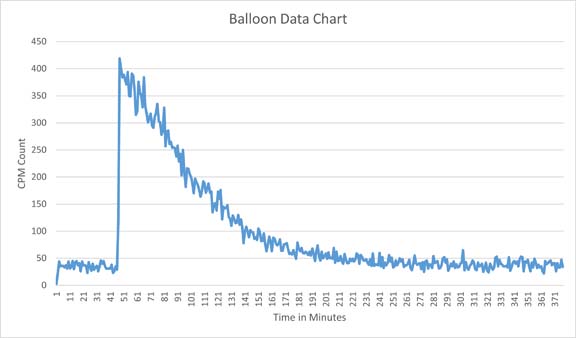Radon nuclides captured in ambient air by electrostatically charged balloon.
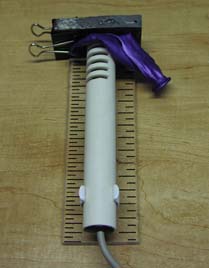
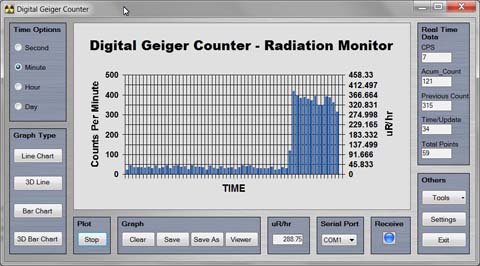
A child’s balloon can be used to make an impressive demonstration. The balloon is inflated. An electrostatic charge is placed on the balloon by rubbing the balloon against one’s hair, sweater or a micro fiber cloth.

The electrostatically charged balloon is suspended in an indoor environment for 60 minutes.
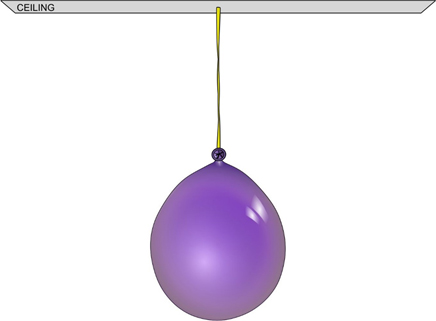 The charged balloon will accumulate radioactive atoms from the decay of radon in the ambient air making the balloon radioactive. The balloon’s radioactivity will increase 10X (or greater) the normal background radiation as detected by a Geiger counter. The Geiger counter must be sensitive to alpha particles to measure the full increase in radioactivity. The origin of this experiment is based on a 1995 paper by Walkiewicz titled “The Hot Balloon (Not Air).”
The charged balloon will accumulate radioactive atoms from the decay of radon in the ambient air making the balloon radioactive. The balloon’s radioactivity will increase 10X (or greater) the normal background radiation as detected by a Geiger counter. The Geiger counter must be sensitive to alpha particles to measure the full increase in radioactivity. The origin of this experiment is based on a 1995 paper by Walkiewicz titled “The Hot Balloon (Not Air).”
Radon is a noble gas. The half-life of radon is 3.82 days. As radon decays the daughter products of radon become attached to positive charge aerosol particles. These positive charged particles are attracted to and captured by the negative charge balloon. The decay of Radon gas follows. Look at this information below, we can see the majority of radioactivity is confined from the decay in the first four steps. The decay of 210Pb takes 22.3 years and can be ignored for our purposes here.
- 222Rn, 3.8 days, alpha decaying to...
218Po, 3.10 minutes, alpha decaying to...
214Pb, 26.8 minutes, beta decaying to...
214Bi, 19.9 minutes, beta decaying to...
214Po, 0.1643 ms, alpha decaying to...
210Pb, which has a much longer half-life of 22.3 years, beta decaying to...
210Bi, 5.013 days, beta decaying to...
210Po, 138.376 days, alpha decaying to...
206Pb, stable.
We do not know in what proportion the balloon has accumulated the various daughter nuclides. Therefore the half-life of the radioactivity captured on the balloon will vary. It is safe to estimate the half-life of the balloon’s radioactivity will be between 30 and 40 minutes. If we look at the decay of 218Po, its half-life is only 3.1 minutes. In 21 minutes its contribution to the radioactivity will be 1/128 of its original amount. The Geiger counter’s sensitivity to the various energies of the decay radiation also plays a part. From the Radon decay sequence shown above the majority of the radiation is beta and alpha radiation.
Doing the Experiment
Inflate the balloon. I tied the end of the balloon with a wire tie to seal it. I used a wire tie because it allows me to remove the tie and gently deflate the balloon. One doesn’t want to knock off all the radioactive nuclei on the balloon surface by popping the balloon.
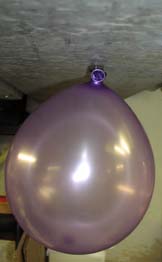
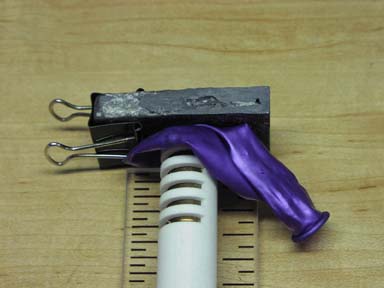
The following picture shows the graphing software response from background radiation to when the balloon is placed in front of the GM tube. The software graph shows about one hour of data.

The data from 6 hours of the software readings were saved and then exported into a CVS file that was loaded into an excel spread sheet and graphed, see below.
